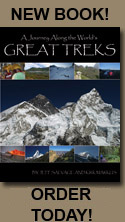 |
 |
Inca Trail, Peru
 Step back in time along ancient stone paths created by the Inca to transport men and material. Immerse yourself for four days in fog-laden trails where the discerning eye may spy many of the 500 species of orchids. Along the way pass snow-capped peaks, lush cloud forests, ancient culture and some of the world’s most famous archeological ruins. Your trek culminates waking up to sunrise over the famed stone works of Machu Picchu, enigmatic ruins built over 500 years ago. Hewn on top of a mountain, this beautiful city’s mystery and beauty captivates all who behold it. It’s popularity has soared in recent years and sometimes it can be downright crowded with 500 people per day entering the trail.
Step back in time along ancient stone paths created by the Inca to transport men and material. Immerse yourself for four days in fog-laden trails where the discerning eye may spy many of the 500 species of orchids. Along the way pass snow-capped peaks, lush cloud forests, ancient culture and some of the world’s most famous archeological ruins. Your trek culminates waking up to sunrise over the famed stone works of Machu Picchu, enigmatic ruins built over 500 years ago. Hewn on top of a mountain, this beautiful city’s mystery and beauty captivates all who behold it. It’s popularity has soared in recent years and sometimes it can be downright crowded with 500 people per day entering the trail.
Fundamentals Days Trekking: 4-5 days
Highlights
When to Go The main trekking season is from May to September, with April and November also providing reasonable trekking. However, as with most popular treks when in season the trails are quite crowded.
Guided vs Independent Treks A guided tour is required for all trekkers, although some of the more aggressively independent trekkers may find a way. However, there are so many companies available for hire in Cuzco it is easy to find one that matches your budget and level of comfort. Porters are available for hire so take a load off and give a job to a local. The load weight is meticulously monitored at the starting point and along the trail, as Peruvian law is careful not to overload their young men. Load maximum is 20 kilos (44 pounds).
Access / Local Information The access city is the charming town of Cuzco. A myriad of travelers services are available in all range of price and quality. The town square is beautiful and the surrounding villages and ruins will keep you occupied for very interesting exploratory and side trips. Cuzco is accessible from Lima by flight or a grueling bus journey. Cuzco is accessible from La Paz by Bus or a bus and train combination. From Cuzco the trail head can be accessed by train, private bus or public bus. |
Orientation The Inca trail and Machu Picchu are located in the Central Andes of Peru. Lima is the capital of Peru and the major arrival point for international Travelers. La Paz Bolivia is closer but does not have the same level of flight connections. Cuzco is the jumping off point for the Inca Trail.
Difficulty The main trek is a four-day, three-night adventure. There is a shorter three-day, two-night version, although we strongly recommend the longer version. The trek can be challenging. Trudging up Dead Woman’s Pass on the second day can take a toll. It tops out at 4,200m / 13,770’, so some acclimatizing is helpful. It is likely you will have spent some time in Cusco, to help your body adapt. However, climbing is only one of the issues. The descent can also be troubling if there is a lot of precipitation, because the trail can get fairly muddy and slippery. In addition, the stone paths can brutalize your knees when descending so make sure you strengthen your quadriceps and hamstrings in the months prior to your trip.
Inca Trail Map |
![]()
Day to Day Account - Jeff Salvage - Inca Trail
![]() After returning from Burma, the seed of walking the ten best treks in the world was sprouting. The Inca Trail with it's prized ruins of Machu Picchu at the end has always been on my short list of destinations. When the opportunity arose to head south with a friend Matt from the University I teach at presented itself, we jumped on it. The story continues...
After returning from Burma, the seed of walking the ten best treks in the world was sprouting. The Inca Trail with it's prized ruins of Machu Picchu at the end has always been on my short list of destinations. When the opportunity arose to head south with a friend Matt from the University I teach at presented itself, we jumped on it. The story continues...

